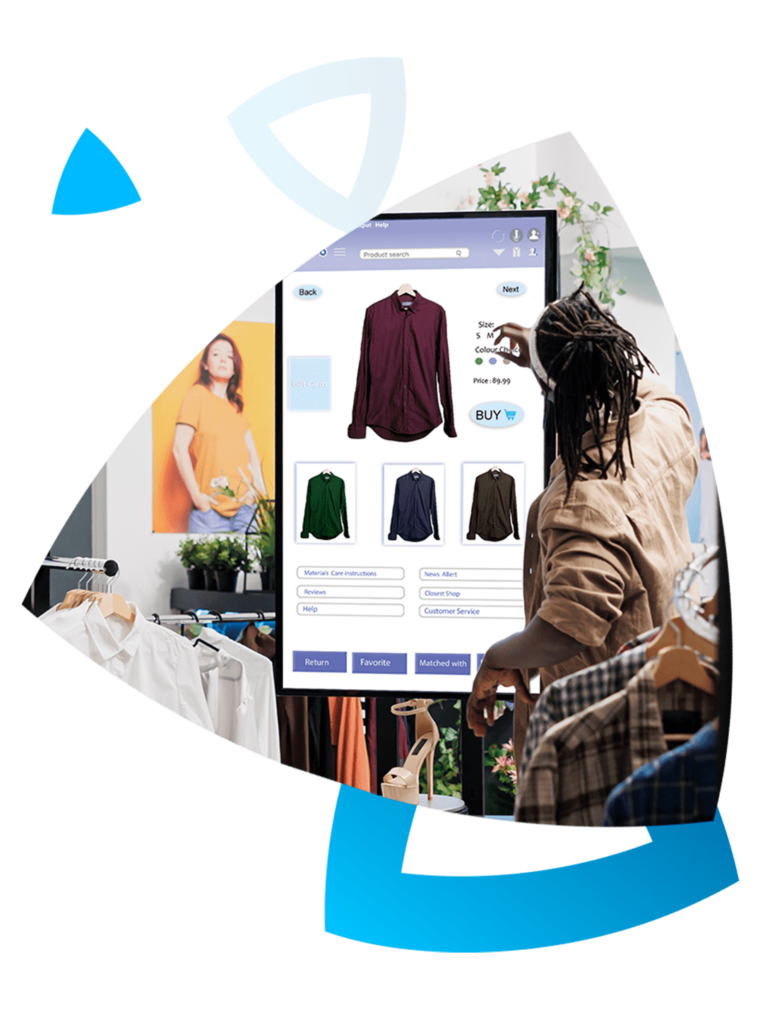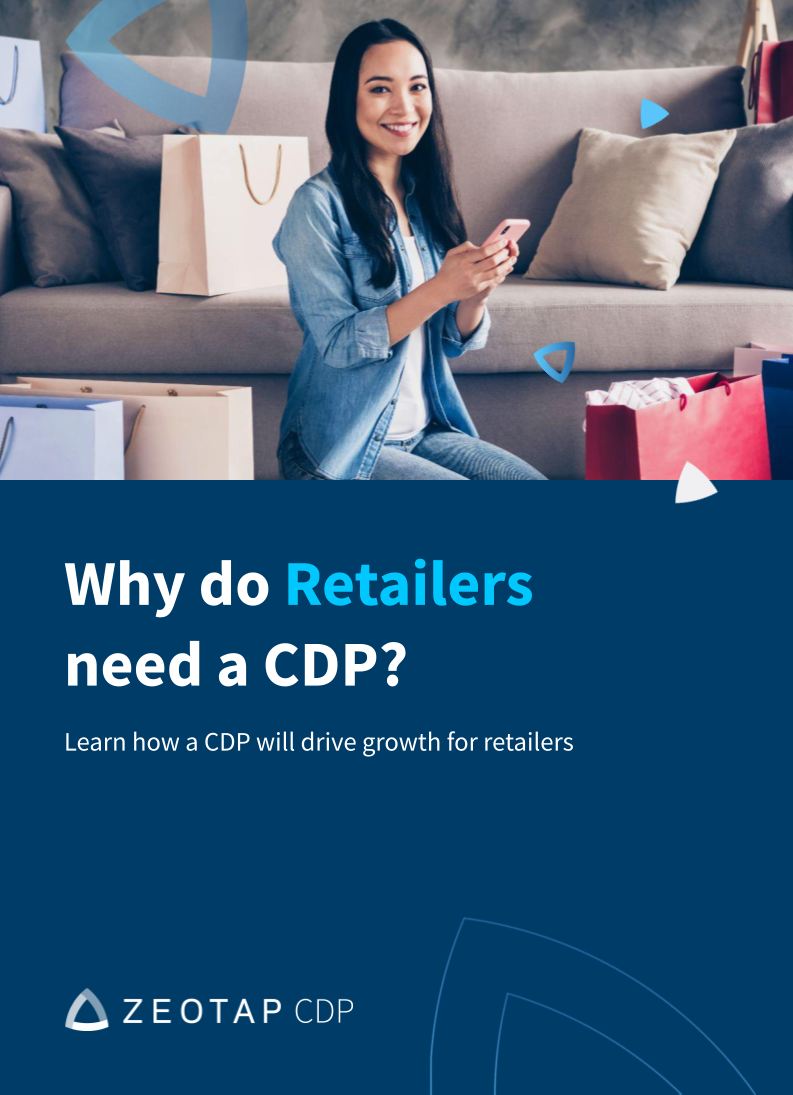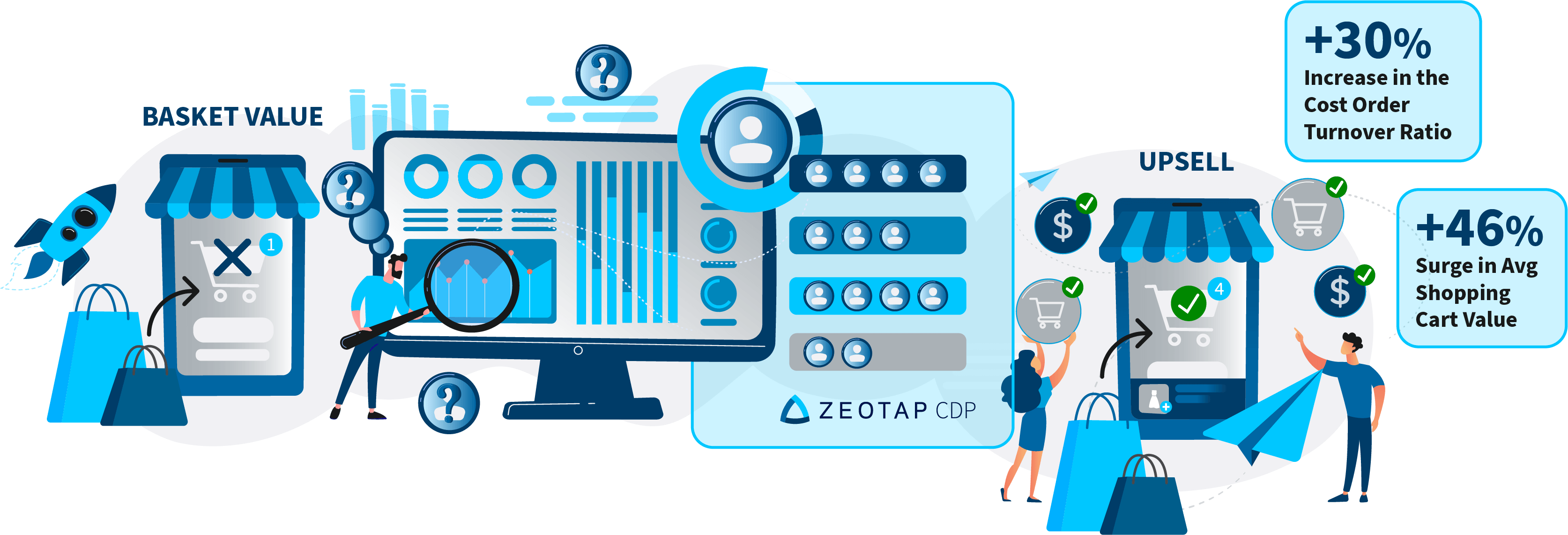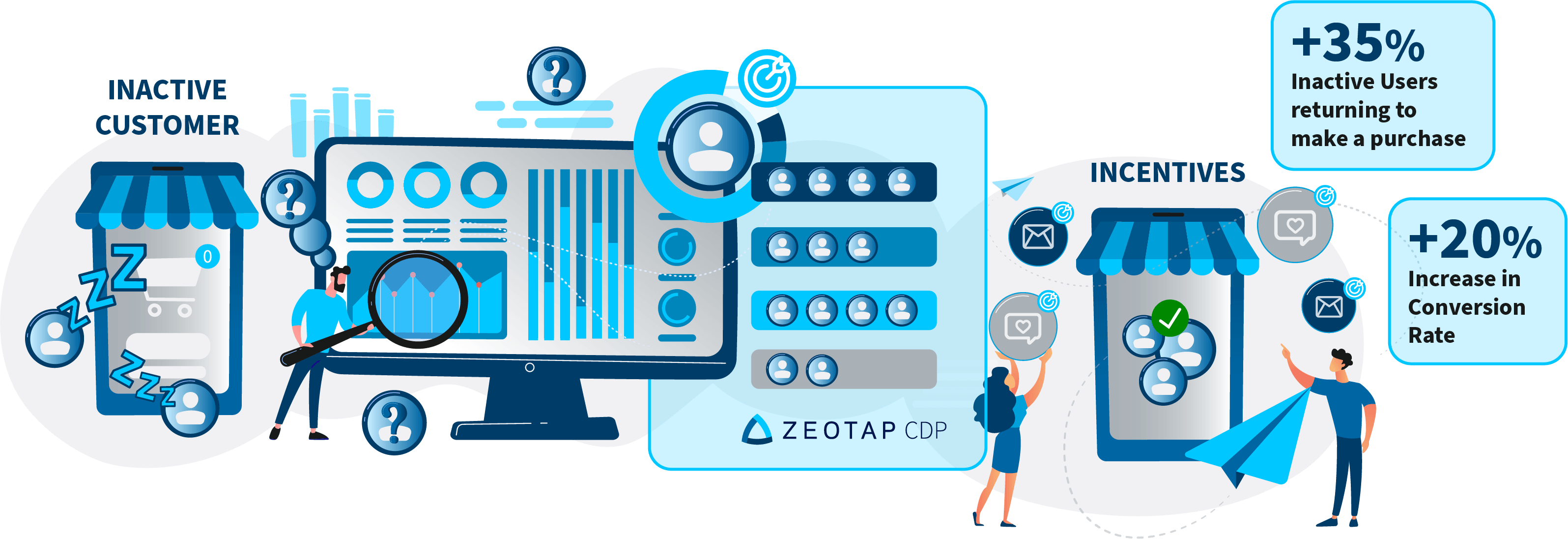Industries
The effective CDP for Data-Driven Retail
Adopt a real Data-driven strategy to drive omnichannel personalisation, prevent churn and foster loyalty

Data-driven retail strategy: an efficient approach to marketing
Unlock the power of informed decision-making with a data-driven approach. This strategy is crucial for anticipating customer needs, tailoring experiences to individual preferences, and streamlining operations for superior results.
At the core of this approach is our Customer Data Platform (CDP), which simplifies and enhances your retail strategy:

- Collecting Data Seamlessly: Capture customer information from every interaction, whether online or in-store, to ensure no valuable insight is overlooked.
- Building Unified Customer Profiles: Consolidate this data to break down silos and form comprehensive profiles, providing a complete view of each customer.
- Segmenting with Ease: Organise your customers into groups based on their preferences, behaviours, and demographics for more effective targeting.
- Activating Across Channels: Apply these segments to customise your marketing across various channels, making sure your communications are always relevant and engaging.
- Monitoring and Adapting: Continuously monitor how customers interact with your brand in real-time and adapt your strategies to respond to changing demands promptly.
Top 5 CDP use cases for retailers
By leveraging a robust CDP and its comprehensive customer insights, retailers can achieve a myriad of objectives, from recovering abandoned carts to enhancing customer loyalty. Explore below to learn how a CDP can revolutionise your retail operations across various key areas.
Recover Abandoned Carts
Retailers face challenges in understanding customer behaviour and recovering lost sales due to cart abandonment. Personalised follow-up strategies, like email reminders and incentives, help re-engage customers and recover lost sales.
Why It Matters: Analysing customer data can uncover pain points and cart abandonment patterns. Personalised follow-ups based on behaviour and demographics can drive conversions and recover lost sales. Understanding these insights is crucial for retailers to craft effective strategies, making a CDP invaluable.
Zeotap Success Story: A leading retailer faced the challenge of understanding customer behaviour and recovering lost sales due to cart abandonment. Crafted for precision, Zeotap CDP utilised user behaviour data to create comprehensive customer profiles, which were then used to craft personalised journeys effortlessly through the intuitive interface. Using automated triggers, the retailer enabled strategic re-engagement across multiple channels, driving conversions and fostering lasting customer loyalty. The implementation resulted in a remarkable 15% increase in conversion rates with personalised email reminders, and an impressive 42% of inactive users returned after receiving personalised offers.
Increase Average Order Value (AOV)
Retailers aim to boost AOV by encouraging customers to add more items to their shopping carts. Personalised product recommendations enhance the shopping experience, leading to higher conversions and AOV.
Why It Matters: Offering personalised incentives like discounts or free shipping can create opportunities for upselling and cross-selling strategies. By leveraging algorithms and customer data through a CDP, retailers can tailor recommendations to individual preferences, driving exploration of additional items and increasing AOV.
Zeotap Success Story: A retailer faced the challenge of enhancing the shopping experience to drive higher conversions and increase AOV. Zeotap CDP's precision-crafted solution seamlessly consolidated user behaviour and purchase data to create nuanced customer profiles. These profiles were enriched with diverse data points, comprising both Customer and Non-Customer Entity Data, including product catalogues and order data. They effortlessly segmented high-value customers, facilitating personalised offerings and member programs through precise cross-channel targeting strategies. The outcome was remarkable: a 30% increase in the Cost Order Turnover Ratio and a 46% surge in Average Shopping Cart Value.
Re-engage Inactive Users
Understanding why users become inactive is crucial for retailers. Reconnecting with abandoned cart customers and inactive users is essential to prevent churn and regain lost revenue.
Why It Matters: Examining customer data to identify reasons for inactivity can help in deploying targeted campaigns that offer incentives or personalised recommendations, encouraging customers to complete purchases. Leveraging a CDP to identify high-intent actions can trigger messages to push inactive customers toward conversion.
Zeotap CDP Success Story: A Retailer wanted to understand why some of the users became inactive. Zeotap CDP, tailored for accuracy, aggregated user behaviour and purchase data, offering a 360-degree customer view. Leveraging this, the retailer identified reasons for inactivity and deployed targeted campaigns, driving a remarkable 20% increase in conversion rates. By analysing inactive user browsing behaviour, Zeotap CDP enables personalised recommendations, resulting in 35% of inactive users returning to make purchases. This approach not only prevents churn but also revitalised lost revenue, showcasing the power of data-driven re-engagement strategies.
Retain Customers and Improve Loyalty
Retailers often prioritise repeat purchases over genuine customer loyalty with outdated programs. However, by tailoring digital content and experiences, along with personalised incentives, they can foster stronger bonds and enhance long-term loyalty.
Why It Matters: Retail shoppers seek convenience but may find the shipping process daunting. Loyalty programs, powered by tailored content, elevate the shopping experience and drive repeat purchases. With a CDP, retailers can track and leverage customer data to deliver relevant messages across channels, enhancing customer retention.
Zeotap Success Story: A retailer wanted to foster stronger bonds with the customer and enhance long-term loyalty. By seamlessly syncing data across online and offline touchpoints, Zeotap CDP shattered data silos, offering a unified view of each customer. Leveraging the Audience module, effortless segmentation, and A/B testing functionalities they gathered deeper insights into customer behaviour. The same was used to craft real-time, personalised communications. The results were impressive: a 15% increase in Customer Lifetime Value compared to the previous year and a notable 10% decrease in the Churn Rate, showcasing the effectiveness of Zeotap CDP in driving sustainable business growth and customer retention.
Suppress Existing Customers from Irrelevant Ads
Retailers strive to enhance marketing effectiveness by ensuring ads are relevant to existing customers. Outdated systems often lead to annoyance with irrelevant ads, wasting ad spend and reducing future effectiveness. Suppressing existing customers from irrelevant ads is crucial to enhance satisfaction and campaign impact.
Why It Matters: Personalised strategies, powered by a CDP and advanced algorithms, can enable retailers to exclude customers who have already purchased specific products from receiving redundant ads. Targeted messages deployed when customers are most receptive drive additional purchases without overwhelming them with irrelevant ads.
Zeotap CDP Success Story: A retailer faced the challenge of ensuring ad relevance to existing customers, as their outdated systems often resulted in annoyance with irrelevant ads, wasting ad spend. Our advanced ID Strategy integrated online and offline data to identify unique customer profiles for suppression. The retailer effortlessly created suppression audience segments to exclude them from digital advertising campaigns. Results include a 38% increase in Click-Through Rate (CTR) and a 20% decrease in Cost Per Order (CPO) across channels.
| Use Case | Timeline | Complexity | Business Impact |
|---|---|---|---|
| Suppress Existing Customers from Irrelevant Ads | 1 month* | Low | 38% Increased CTR 20% Decreased CPO |
| Re-target Abandoned Carts | 1-2 months** | Low/Medium | 15% Increased Conversion Rate 42% Increase in Returning Inactive Users |
| Re-engage Inactive Users | 1-2 months*** | Low/Medium | 20% Increased Conversion Rate 35% Increase in Returning Inactive Users |
| Increase Average Order Value | 2-3 months**** | High | 30% Increased Cost Order Turnover Ratio 46% Increase in Average shopping Cart Value |
| Retain Customers and Improve Loyalty | 3-4 months***** | High | 15% Increased CLV 10% Decrease in the Churn Rate |
*to get started with the first campaign and then drive business impact with granular segmentation for the next couple of months
**to get started with simple abandoned cart follow-up use case. Possibility to drive further business impact with more granular user qualification/customer journeys afterward
***upload simply vs more granular user segmentation can start right away to re-engage inactive users
****to build sophisticated engagement segmentation and increase AOV/CLV accordingly
*****to leverage results and insights of previous campaigns to retain customers and improve brand loyalty
Make your retail business strategy a success
Download our free whitepaper “Why do Retailers need a CDP?”
and discover how to apply a data-driven approach
using Zeotap CDP
How DOUGLAS maximised its data potential with Zeotap CDP
Douglas urgently needed a vendor that could ensure top-tier data safety and privacy, offer user-friendly solutions with swift integrations, and provide a collaborative and trust-based partnership.
Main goals
- Achieve a comprehensive 360-brand activation
- Internationalise and explore new secure channels
- Establish a robust data and adtech architecture
- Transition from DMP to CDP for improved targeting
in a future without 3P cookies

How Breuninger improved its marketing efficiency with Zeotap CDP
Breuninger aimed to future-proof and enhance the effectiveness of their re-targeting efforts. The primary goal was to optimise the customer targeting strategy to increase efficiency and personalisation.
Main objectives:
- Cross-Channel Suppression
- High-Value Branded Ad Retargeting
- Wishlist Retargeting
- Cart Abandonment Retargeting
+30% COST ORDER TURNOVER RATIO
+46% INCREASE IN AVG. BASKET VALUE

REWE Data-driven approach with Zeotap CDP
Discover how Rewe, the German high-quality foods supermarket chain, improved their marketing strategy, with a data-driven approach.
Learn how first-party data and Zeotap CDP are reshaping customer engagement and driving retail growth.
Watch the video to gain valuable insights and actionable strategies through real-world examples and use cases.
Boost your Retail data-driven strategy with our CDP solution

In our whitepaper you will learn:
- How to navigate the unpredictable customer journey
- How to gain a true, actionable 360-degree view of customers
- How to adopt a data-driven strategy to deliver unique experiences that meet customers’ needs across the entire customer journey
Fill out the form and download the free guide!










